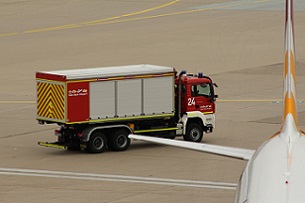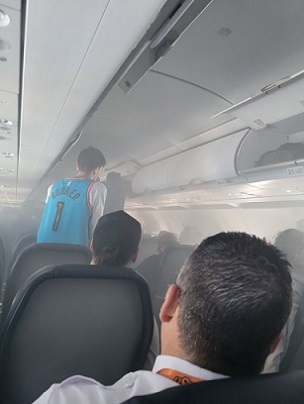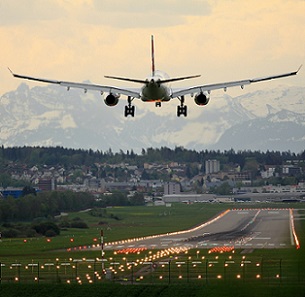 Airport fire engine. Image by Markus Böhm on free photo website Pixabay.
Airport fire engine. Image by Markus Böhm on free photo website Pixabay.
 Smoke in an aircraft cabin after a lithium battery catches fire in an overhead locker
Smoke in an aircraft cabin after a lithium battery catches fire in an overhead locker
 A pilot with an AvSax lithium battery fire mitigation bag
A pilot with an AvSax lithium battery fire mitigation bag
 Many aircraft make emergency landings after lithium batteries overheat or catch fire on board
Many aircraft make emergency landings after lithium batteries overheat or catch fire on board
Airport fire stations are starting to equip themselves with an award-winning lithium battery fire prevention device after an increase in battery fires on planes.
The problem is growing worldwide with planes often diverting and making emergency landings if electronic devices powered by lithium batteries start to overheat or even catch fire.
Although more than 16,700 passenger planes worldwide now carry AvSax lithium battery fire prevention bags specially designed for use on board aircraft, thousands more don’t which is why firefighters need to be prepared for when they land.
They would also get called to any lithium battery fire incidents anywhere in the airport and its terminal buildings.
When batteries overheat they go into what’s known as thermal runaway which happens when one cell in a battery overheats it can produce enough heat – up to 900°C (1652°F) – to cause adjacent cells to overheat. This can cause a lithium battery fire to flare repeatedly and, because they burn at such a high temperature, they are very difficult to put out.
Aircraft equipped with AvSax can quickly solve the problem by putting the device into the bag and every time an AvSax has been used on a plane it has not had to make an emergency landing.
But there are many emergency landings each year by aircraft not equipped with AvSax which is why firefighters need to be ready as soon as the plane comes to a halt to get on board and get the device into an AvSax to mitigate the danger while passengers are disembarking.
There have been 446 lithium battery incidents reported in US airspace from March 2006 to May 2023 – 24 recorded so far this year alone - but figures for UK airspace and the rest of the world are not made public.
AvSax won the Queen’s Award for Enterprise in the UK for its potentially life-saving innovation. It was devised by Richard Bailey, managing director of Environmental Defence Systems Ltd based in West Yorkshire, England, who said: “Some airport fire stations already have AvSax and we are getting inquiries from others which suggests more and more aircraft are coming into land with overheating devices and even some which have caught fire and have been made as safe as possible until the plane lands.”
Lithium batteries are used to power all kinds of electronic devices including mobile phones (cellphones), iPads, laptops, headphones and even vapes.
The organisation covering flight safety in the UK, the Civil Aviation Authority, says a fire caused by a lithium battery could cause catastrophic damage to an aircraft and even bring it down.
It states: “Poor quality or counterfeit batteries have been the cause of fires on board aircraft. In recent years we’ve seen a growing number of fire incidents involving lithium batteries which have the potential to lead to the loss of an aircraft. All types of batteries must pass stringent tests. Batteries which are not tested such as counterfeit batteries pose a significant risk to flight safety.
“Any fire on board an aircraft, particularly one involving lithium batteries, has the potential to be catastrophic. There have been occasions where incidents involving lithium batteries have occurred in the passenger cabin. Prompt actions of cabin crew and subsequent actions by the flight crew can avoid an inflight fire becoming uncontrollable with potentially disastrous consequences. Therefore, it is important the cabin crew respond quickly.”
Each airline company has its own procedure for dealing with the danger but the one preferred by the CAA is to use specialist battery fire containment bags as they are designed to deal with the problem in seconds. The CAA warns that these so-called burn bags must be able to both cool and contain the device … and AvSax does both.
The CAA adds: “After knocking down flames it could conceivably take just a couple of seconds for a PED to be placed inside a containment bag, allowing it to be moved to a place of safety.
“Passengers could then return to their seats, mitigating potential unrelated safety hazards such as injury in the case of severe turbulence. Equally, the effect on flight crew carrying out their duties following an event on the flight deck would be minimised.”
How do AvSax work?
If an electronic device starts to overheat or emit smoke the cabin crew will pour at least two litres of water into an AvSax. It is imperative to first knock down the flames from the device using an on-board halon fire extinguisher, then transfer the device into AvSax before it reignites. Additional water is then required. The water activates the polymer gel inside the bag causing it to expand around the device. Should the device keep on venting then the AvSax is tough enough to absorb the energy.
The AvSax cools the batteries in the device, reducing the likelihood of the battery igniting but if it does go into thermal runaway with all the battery cells igniting it’s all contained within the bag. Tests have shown that AvSax can withstand exploding detonators or battery packs.
Amazingly, the water is absorbed into the internal lining of the bag so the device is dry when it is removed.
To find out more go to http://avsax.com/